| Lomatium ravenii | |
|---|---|
| Scientific classification | |
| Kingdom: | |
| (unranked): | |
| (unranked): | |
| (unranked): | |
| Order: | |
| Family: | |
| Tribe: | |
| Genus: | |
| Species: | L. ravenii |
| Binomial name | |
| Lomatium ravenii Mathias & Constance | |
Lomatium ravenii is a species of flowering plant in the carrot family known by the common names Lassen parsley and Raven's lomatium. It is native to the Great Basin of the United States, where it grows in sagebrush and other plateau habitat, including areas with somewhat alkaline soils in Nevada, California, and other states.
Lomatium ravenii is a hairy, gray-green perennial herb growing 5 to 40 centimeters long from a taproot and tuber unit. There is generally no stem, the leaves and inflorescence emerging at ground level. The leaf blades are divided into segments which are subdivided into smaller oval or knoblike segments. The inflorescence is a hairy umbel of white or purple-tinged flowers with dark anthers.
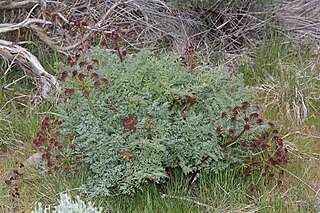
Lomatium dissectum is a species of flowering plant in the carrot family known by the common name fernleaf biscuitroot. It is native to much of western North America, where it grows in varied habitat. It is found in the eastern slopes of the Cascade Range, Rocky Mountains, Klamath Mountains, eastern Transverse Ranges and the Sierra Nevada in California.

Lomatium macrocarpum is a perennial flowering plant in the carrot family known by the common names bigseed lomatium, biscuit root or bigseed biscuitroot. It is native to much of western North America, where it can be found in various types of habitat, including the grasslands of the Great Plains. It is spreading or erect perennial herb growing up to about half a meter long with hairy, gray-green herbage. The leaves are up to about 24 centimeters long and are intricately divided into many small, narrow segments. The inflorescence bears an umbel of yellowish, purplish, or white flowers. The fruit is a compressed, winged, round or oval disc up to about 2 centimeters long.

Lomatium utriculatum is a species of flowering plant in the carrot family known by the common name common lomatium or spring gold. It is native to western North America from British Columbia to California, where it grows in many types of habitat including chaparral, and in the Sierra Nevada.
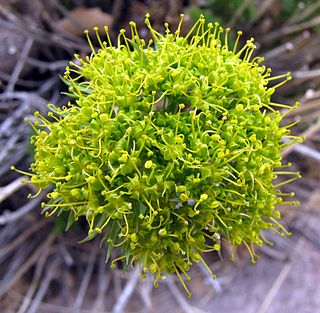
Lomatium parryi, commonly known as Parry's biscuitroot and Utah desertparsley, is a perennial herb in the carrot family. It is a common herb in high altitude areas of deserts and common in desert National parks, such as Death Valley mountains, in the western part of the United States.
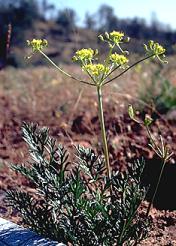
Lomatium congdonii, known by the common names Mariposa desertparsley and Congdon's lomatium, is a species of flowering plant in the carrot family.

Lomatium foeniculaceum is a species of flowering plant in the carrot family known by the common name desert biscuitroot. It is native to much of western and central North America, where it grows in many types of habitat.
Lomatium ciliolatum is a species of flowering plant in the carrot family known by the common name Yolla Bolly biscuitroot. It is endemic to California, where it is known from the mountain ranges adjacent to the north and south of the San Francisco Bay Area, at 300–600 feet, 1200–2100 m. It is often a member of the serpentine soils flora in woodland and chaparral habitat.
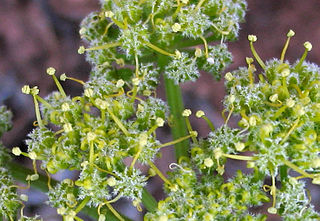
Lomatium dasycarpum is a species of flowering plant in the carrot family known by the common name woollyfruit desertparsley. It is native to California and Baja California, where it is widespread throughout many of the mountain ranges, including the Peninsular, Sierra Nevada, and California Coast Ranges, and in valleys.
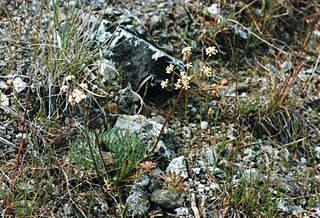
Lomatium engelmannii is an uncommon species of flowering plant in the carrot family known by the common name Engelmann's desertparsley, or Engelmann's lomatium. It is native to the Klamath Mountains of southern Oregon and northern California, where it is a member of the local serpentine soils flora.
Lomatium marginatum is a species of flowering plant in the carrot family known by the common name butte desertparsley. It is endemic to California, where it is known from mountains, valley, and grassland habitat, including serpentine, in the northern half of the state. It is a perennial herb growing up to about half a meter tall from a small taproot. There is no stem, and the leaves and inflorescence emerge from ground level. The purple-green leaves may approach 30 centimeters long, their blades divided into many long, narrow segments. The short but wide inflorescence bears an umbel of yellowish, purplish, or reddish flowers. The Lomatium marginatum is not currently an endangered species.

Lomatium mohavense is a species of flowering plant in the carrot family known by the common name Mojave desertparsley. It is native to southern California with a few outlying populations in Arizona, Nevada and Baja California. It is found in several types of mountain and desert habitat, including chaparral, woodland, and scrub, mostly from 2,000–7,000 feet (600–2,100 m) elevation.

Lomatium nevadense is a species of flowering plant in the carrot family known by the common name Nevada biscuitroot. It is native to the western United States and northern Mexico, where it is known from several different habitat types, including sagebrush and woodlands. It is a perennial herb growing up to about 45 centimeters tall from a taproot. The leaves are up to about 16 centimeters long, their blades divided into many oblong pointed segments. The inflorescence is an umbel of white or cream flowers.

Lomatium parvifolium is an uncommon species of flowering plant in the carrot family known by the common names coastal biscuitroot and small-leaved lomatium. It is endemic to California, where it is known only from the Central Coast and central California Coast Ranges. It grows in pine forests and other habitat on serpentine soils.
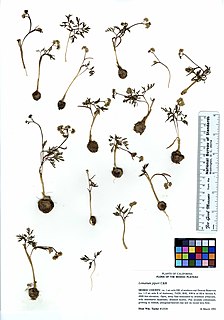
Lomatium piperi is a species of flowering plant in the carrot family known by the common name salt-and-pepper or Indian biscuitroot. It is native to the Northwestern United States and northern California, where it grows in sagebrush and plateau habitat, and the Sierra Nevada and Cascade Mountains.

Lomatium rigidum is a species of flowering plant in the carrot family known by the common names Big Pine biscuitroot and stiff lomatium. It is endemic to Inyo County, California, where it is known only from the wilderness around the Big Pine area of the Owens Valley.

Lomatium torreyi is a species of flowering plant in the carrot family known by the common name Sierra biscuitroot. It is endemic to the Sierra Nevada of California, where it grows in the forests of the high mountains.

Lomatium tracyi is a species of flowering plant in the carrot family known by the common name Tracy's desertparsley, or Tracy's lomatium. It is native to the mountains of northern California and southern Oregon, where it grows in the forests on the slopes, often on serpentine soils. It is a perennial herb growing up to 35 centimeters tall from a slender taproot. There is generally no stem, the leaves and inflorescence emerging at ground level. The leaf blades are divided and subdivided into a mass of overlapping threadlike to oval segments. The inflorescence is an umbel of yellow flowers.

Lomatium triternatum is a species of flowering plant in the carrot family known by the common name nineleaf biscuitroot. It is native to western North America from British Columbia to California to Colorado, where it grows in many types of habitat. It is a hairy perennial herb growing up to a meter tall from a taproot. The leaves emerge from the lower part of the stem. Each is generally divided into three leaflets which are each subdivided into three linear leaflike segments. The inflorescence is an umbel of yellow flowers, each cluster on a ray up to 10 centimeters long.

Lomatium observatorium is a rare species of flowering plant in the carrot family known by the common names Mt. Hamilton desertparsley and Mount Hamilton lomatium. It is endemic to California, where it is known only from the mountains of Santa Clara County, including Mount Hamilton near the Lick Observatory. It may also occur in Stanislaus County. Its habitat includes mountain woodlands on volcanic and metamorphosed sedimentary rock substrates. Described The plant to science as a new species in 1996, the plant is a perennial herb growing low to the ground, the lightly hairy herbage growing from a long taproot.
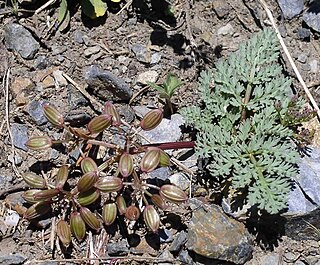
Lomatium erythrocarpum, known by the common name redfruit desertparsley, is a rare species of flowering plant in the carrot family. It is endemic to Oregon in the United States, where it is limited to a section of the Blue Mountains within Baker County.